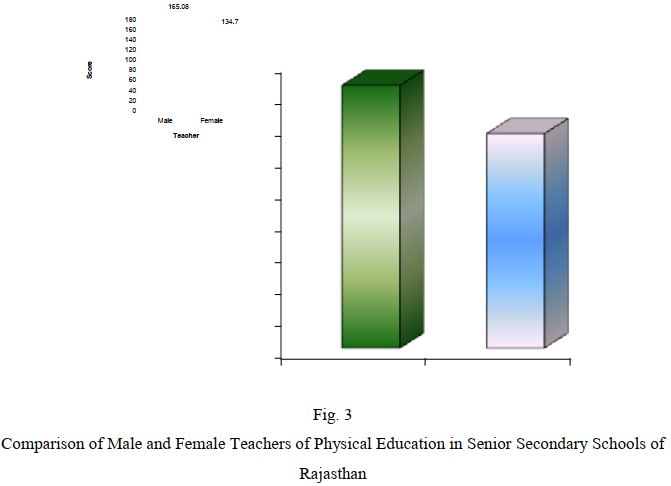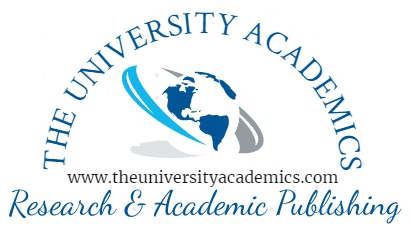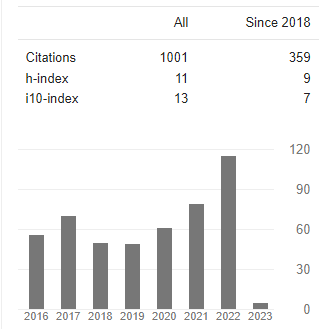COMPARISON OF PHYSICAL EDUCATION TEACHER EFFECTIVENESS AT DIFFERENT LEVEL OF SCHOOLS IN RAJASTHAN
Abstract
The end result of all training is to make men fully grown. It is further felt that in the whole educational process, there are many factors which separately or collectively determine the quality of education. The objective of the study was to compare the teaching abilities of male and female teachers of physical education at different level schools of Rajasthan and to compare the teaching abilities of male and female teachers of physical education in middle and high schools. It has been hypothesised that there will be a significant difference between middle and high schools male and female physical education teachers of Rajasthan that there will be significant difference between physical education male and female teachers of middle and senior secondary schools of Rajasthan. The overall sample of 450 physical education teachers were selected. Result showed that the value of Mean and Standard Deviation of physical education male teachers (131.54 and 14.52) and female teachers (117.54 and 18.28) of physical education respectively. It was concluded that the male teachers of physical education are more effective than the female teachers of physical education at the different level of schools and the sex difference plays an important role in teaching.
Downloads
References
Allen, M. Barnes, William, D., Gerald, L., Robexon, E.W., Teacher Self-Appraisal, Ohio: Charles, A. Jones Publishing Co., Washington, 1970, p.21.
Boyd Mary, Ann, The emotional intelligences of teachers and student’s perception of their teacher’s behaviour in the classroom, 66(3), September 2005.
Chandra, Dinesh and Kumari Manorama, A study of emotive aspects of work perceived by effective and ineffective teachers, Quest in Education, 1980, Vol. XVII (2), pp.173-180.
Chaube, J.S., A study of relationship among teaching efficiency, attitude towards teaching profession and academic achievement of B.Ed. students, Agra, The Asian Journal of Psychology and Education, Vol. 15, No. 2, 1985.
Chaudhary, S., Relationship between creative thinking abilities of student teachers and intellectual climate index of the classroom, Indian Education Review, Vol. 24, No. 3, July 1989.
Deo, Pratibha, Some personality and adjustment correlates of teaching effectiveness, Punjab Journal of Educ., 1974, Vol. 3-4(1-4), p.18.
Deva, R.C., Prediction of students teaching success, Journal of Educ. and Psyc., 1979, XXXVII (2), pp.139-147.
Flander, N.A., Analysing teaching behaviour, London: Addisionwisely Publishing Co. Inc., 1970.
Gakhar, S.C., Teacher’s attitude as a factor in the learning of mathematical concepts by students. Journal of Educational Research and Extension, Vol. 19, No. 2, 1982.
Hausman, Charles S. and Goldring, Ellen B., Sustaining teacher commitment: the role of professional communities, Peabody Journal of Education, Vol. 76, No. 2, 2001, pp.30-51.
Jayamma, M.S., Construction and standardization of an inventory for predicting teacher efficiency (for the primary school teachers of Mysore state), Doctorate Dissertation in Education, MS University, 1962.
Roy, B., Changing teacher behaviour through feedback research report, National Council of Educational Research and Training, New Delhi, 1970.
Sharma, S.C., Preservice selection of teachers – a review of research, Journal of Educ. and Psy., Vol. XXIX (2), 1971, pp.158-163.
Sharma, T.R., Lecturer evaluation by Indian students, Manas, Vol. 19(1), 1972, pp.65-67.
Singh, Harbhajan and Singh, Daljit, Students perception of teacher effectiveness, Journal Educ. and Psychol., Vol. XXXII (4), 1975, pp.213-216.
Sundarajan, S.; Kumar, Krishna R. and Bala Krishnan, K., Student teacher’s attitude towards teaching and their interest in it, Experiments in Education, Vol. XIX(10), October 1991.
Yourglich, Anita, Study on correlation between college teacher and students concepts of ideal students and ideal teacher, Journal Educ. Resech., Vol. 49, 1955, p.59-64.















